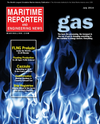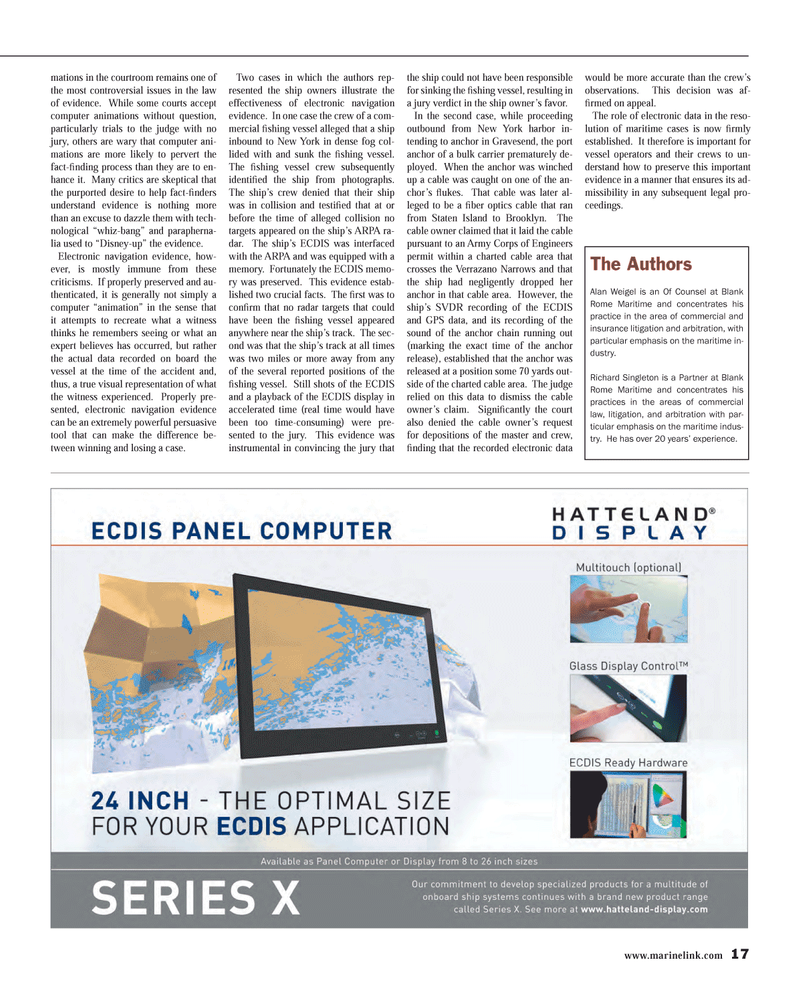
Page 17: of Maritime Reporter Magazine (July 2014)
Offshore Energy Structures & Systems
Read this page in Pdf, Flash or Html5 edition of July 2014 Maritime Reporter Magazine
www.marinelink.com 17 mations in the courtroom remains one of the most controversial issues in the law of evidence. While some courts accept computer animations without question, particularly trials to the judge with no jury, others are wary that computer ani- mations are more likely to pervert the fact-fi nding process than they are to en- hance it. Many critics are skeptical that the purported desire to help fact-fi nders understand evidence is nothing more than an excuse to dazzle them with tech- nological “whiz-bang” and parapherna- lia used to “Disney-up” the evidence.
Electronic navigation evidence, how- ever, is mostly immune from these criticisms. If properly preserved and au- thenticated, it is generally not simply a computer “animation” in the sense that it attempts to recreate what a witness thinks he remembers seeing or what an expert believes has occurred, but rather the actual data recorded on board the vessel at the time of the accident and, thus, a true visual representation of what the witness experienced. Properly pre- sented, electronic navigation evidence can be an extremely powerful persuasive tool that can make the difference be- tween winning and losing a case.
Two cases in which the authors rep- resented the ship owners illustrate the effectiveness of electronic navigation evidence. In one case the crew of a com- mercial fi shing vessel alleged that a ship inbound to New York in dense fog col- lided with and sunk the fi shing vessel.
The fi shing vessel crew subsequently identifi ed the ship from photographs.
The ship’s crew denied that their ship was in collision and testifi ed that at or before the time of alleged collision no targets appeared on the ship’s ARPA ra- dar. The ship’s ECDIS was interfaced with the ARPA and was equipped with a memory. Fortunately the ECDIS memo- ry was preserved. This evidence estab- lished two crucial facts. The fi rst was to confi rm that no radar targets that could have been the fi shing vessel appeared anywhere near the ship’s track. The sec- ond was that the ship’s track at all times was two miles or more away from any of the several reported positions of the fi shing vessel. Still shots of the ECDIS and a playback of the ECDIS display in accelerated time (real time would have been too time-consuming) were pre- sented to the jury. This evidence was instrumental in convincing the jury that the ship could not have been responsible for sinking the fi shing vessel, resulting in a jury verdict in the ship owner’s favor.
In the second case, while proceeding outbound from New York harbor in- tending to anchor in Gravesend, the port anchor of a bulk carrier prematurely de- ployed. When the anchor was winched up a cable was caught on one of the an- chor’s fl ukes. That cable was later al- leged to be a fi ber optics cable that ran from Staten Island to Brooklyn. The cable owner claimed that it laid the cable pursuant to an Army Corps of Engineers permit within a charted cable area that crosses the Verrazano Narrows and that the ship had negligently dropped her anchor in that cable area. However, the ship’s SVDR recording of the ECDIS and GPS data, and its recording of the sound of the anchor chain running out (marking the exact time of the anchor release), established that the anchor was released at a position some 70 yards out- side of the charted cable area. The judge relied on this data to dismiss the cable owner’s claim. Signifi cantly the court also denied the cable owner’s request for depositions of the master and crew, fi nding that the recorded electronic data would be more accurate than the crew’s observations. This decision was af- fi rmed on appeal.
The role of electronic data in the reso- lution of maritime cases is now fi rmly established. It therefore is important for vessel operators and their crews to un- derstand how to preserve this important evidence in a manner that ensures its ad- missibility in any subsequent legal pro- ceedings.
The Authors
Alan Weigel is an Of Counsel at Blank
Rome Maritime and concentrates his practice in the area of commercial and insurance litigation and arbitration, with particular emphasis on the maritime in- dustry.
Richard Singleton is a Partner at Blank
Rome Maritime and concentrates his practices in the areas of commercial law, litigation, and arbitration with par- ticular emphasis on the maritime indus- try. He has over 20 years’ experience.
MR #7 (10-17).indd 17 6/30/2014 10:30:59 AM

 16
16

 18
18
